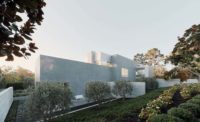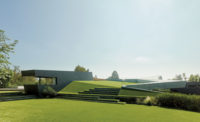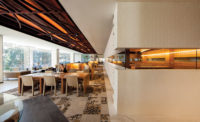San Francisco architect Jim Jennings began his studies as an engineer—not a big surprise considering that his modernist architecture, which includes the award-winning Visiting Artists House in Sonoma County, demonstrates a through-line of formal elegance and rigorous clarity.
Moreover, an engineering feat—a prefabricated structural system that “liberated the floor plan,” Jennings says, by eliminating the need for shear walls—enabled the form of his latest project, in northern California. The single-story, 6,900-square-foot house, a quiet triumph of right angles and rectilinear motifs, rests as a solid, serene presence on a ridge within a nature-filled private development.
The setting is as worthy of contemplation as the house itself, five acres located in the Carmel Valley, a renowned wine-growing region tucked into the Santa Lucia Mountains. Monterey Bay is to the north, and a coastal climate causes constant weather changes, with fog creeping in over the hills. Here Jennings embedded a calm, protective perch for observing these phenomena.
The owners are a retired couple who split their time among New York, Florida, and California. “We knew we wanted a modern house in the old-school sense, inspired by the International Style,” recalls the wife. “I don't like circles or curves.” After hearing about Jennings through friends, the two gave him the basic program, which included space for entertaining visitors and for an adult son. After Jennings toured the property, he took the couple to see a house he'd designed in Napa Valley, which, he says, “is configured to create a series of exterior spaces that interlock it to the site.” The trip sealed the deal.
Though his Carmel Residence doesn't resemble Le Corbusier's prototypical Dom-ino House, it shares some of its DNA, especially the way it relies only on the columns and roof for support. Here, the structure is a steel moment frame, designed and fabricated locally. Its rigid, bolted connections between beams and columns transmit lateral forces directly to the ground, so that walls can simply define interior spaces. Beams, square tube columns, and light-gauge joists were delivered to the site cut to size and predrilled with bolt holes, and the entire structure was assembled in just seven days.
On the exterior, a fascia of dark paper-based composite panels emphasizes the structure's horizontality and helps it blend into its surroundings. A short, inclined driveway leads up to the gravel parking court; the house bounds this area on three sides. With its opaque cladding of ½-inch precast concrete panels, you might think you'd stumbled upon a private art gallery or a chic little hotel. A tree standing sentry near a glazed stretch of facade tips you off to the entrance, and the inscrutability fades as you approach it. The owners originally wanted the front of the house to have more glazing but had second thoughts when they realized a large space was required for vehicles (a fire truck must be able to turn around), which they felt would detract from the views. “Jim was right to suggest less transparency here,” says the husband.
The foyer is placed at the house's midpoint and opens into a sun-dappled hallway, the spine that connects the public and private spaces. This circulation path and nearly every room combines glazed sections and solid partition walls, the latter often topped by clerestories. “Five acres of land gets you a lot of privacy, so we used glass whenever possible,” Jennings says. A grid of mullions and muntins visually breaks down the expanses of glass and frames well-composed views that range from spectacular (one vista extends all the way to Monterey Bay) to intimate (partly enclosed by a rugged wall of native Carmel stone).
Much like the natural world around it, the architecture succeeds in achieving a harmonious and calibrated balance. The skillful layout and well-proportioned rooms make for a home that feels ample and generous but not sprawling. Materials and finishes in earthy grays, taupes, and rusts are a tranquil backdrop on sunny days but add warmth and texture when fog rolls in. And, despite allowing views outdoors from almost anywhere, solid walls and built-ins also keep the spaces humanly scaled and often block views that are less than graceful (a golf course, its clubhouse).
Both Jennings and his clients describe their working relationship as highly collaborative and symbiotic, and the list of superlatives that the couple uses for their new home is long. But none of them could have predicted how well it's been received within the development, where modern-style dwellings are not the norm. During a meeting with the design review committee, the chairperson told the group, “This is the kind of architecture we should be building here.” And neighbors have offered praise or confessed, “I didn't think I'd like your house, but I love how it turned out.”
Size: 6,900 square feet
Construction Cost: Withheld
Completion Date: September 2014
PeopleArchitect: Personnel in architect's firm who should receive special credit: Interior designer: Engineer(s): CIVIL: Consultant(s): Lighting: Other: General contractor: Photographer(s): CAD system, project management, or other software used: |
ProductsMain structural system SECONDARY STRUCTURAL SYSTEM: COLD-FORMED STEEL FRAMING Manufacturer of any structural components unique to this project: Exterior cladding FASCIA PANELS AND EXTERIOR BASEBOARD: RICHLITE RAINSHADOW COMPOSITE PANELS WITH EXPOSED STAINLESS STEEL FASTENERS Precast concrete: Moisture barrier: Roofing Windows Glazing Skylights: Hardware Interior finishes Solid surfacing: Floor and wall tile: Carpet: Special interior finishes unique to this project: Furnishings Tables: Other furniture: Lighting Downlights: Task lighting: Exterior: Dimming System or other lighting controls: Plumbing Energy Photovoltaic system: |





















Post a comment to this article
Report Abusive Comment